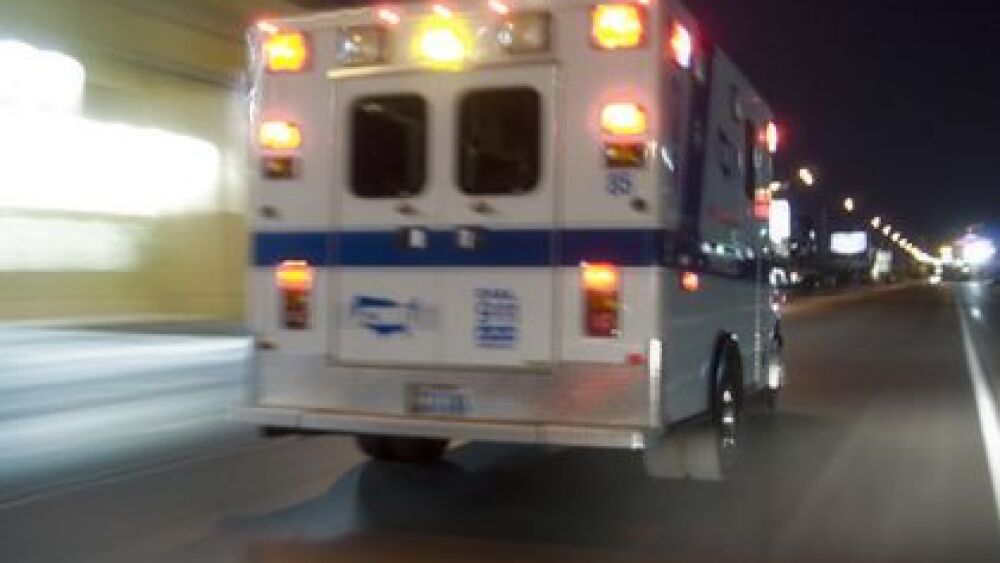By Sarah Calams, EMS1 Associate Editor
A study led by John Hopkins Medicine observed more than 100,000 shooting and stabbing patients from 2010 to 2012 at nearly 300 urban U.S. trauma centers.
Their conclusion: shooting and stabbing victims have a better chance of survival if they use private vehicles over ambulances for transport to a trauma center.
The study found that 2.2 percent of patients who arrived in a private vehicle died versus 11.6 percent of patients who died via ambulance transport.
Additionally, statistics for transport of gunshot victims included:
- 4.5 percent who arrived in a private vehicle died
- 19.3 percent who arrived in an ambulance died
For stabbing victims:
- 0.2 percent who arrived in a private vehicle died
- 2.9 percent who arrived in an ambulance died
The study’s findings caused uproar within the EMS1 community. We asked our Facebook fans about the study’s discoveries; here are your responses.
If you haven’t already, add your thoughts in the comment section below.
1. “Waiting for the scene to be cleared by law enforcement takes time. Medics who don’t load and go take more time. That lifesaving IV can be done en route. Life-threatening gun shots require surgery. I don’t care how many holes you plug from the outside. PHTLS or ITLS covers this extensively.” – Chris Marchese
2. “I suppose if there’s a trauma center down the street, but the closest one to me is 45 minutes away with no traffic. I seriously doubt that transporting someone there in my car, with no medical intervention, would increase their chance of survival.” – Maureen Mackey Sampson
3. “I am someone who survived a GSW and was transported by ambulance. As a result, I’m now an EMT-B and in medic school. Rapid response and professional treatment will always result in higher survival rates for patients.” – Grant Gulden
4. “I’m in an urban area with almost daily shootings. In 99 percent of the cases, the delay in treatment is from waiting for police to secure the scene. It’s common sense to load and go a GSW victim, and here we all do. Interventions are done en route and we have a 10-minute max transport time to our level 2 trauma center. But we are not going to enter the scene until it is clear per police. I wish the article had taken our safety into account.” – Andrea Byrum
5. “There are a lot of factors that could skew those results. Types of and extent of injuries, etc. The more critical patients, perhaps even the ones who die prior to EMS arriving, are obviously more likely to be transported by ambulance. In retrospect, the ones who go in by POV are more likely to have survivable wounds from the beginning, such as an extremity injury.” – Jonathan Hatcher
6. “Ridiculous. EMS can not only assess facility appropriateness (and initiate air if applicable) control bleeding, establish a patent airway, stabilize, etc. But they also alert the incoming facility so the team can be prepared to further take care of the patient. I didn’t even read this whole article. This is an insult to highly trained pre-hospital caregivers and also bad information to share with the public.” – Kristi Cox
7. “I wonder if the study compared BLS vs. ALS outcomes. Also wonder if they controlled for proximity to trauma center. I think people are more likely to use a personally owned vehicle to transport if the trauma center is nearby. I think the takeaway for those of us in EMS should be: stop doing IVs on scene. Load and go.” – Keith Hart
8. “I have a friend who worked at Maryland Shock Trauma and she tells me she gets more people with stab wounds or GSW thrown out of cars then by ambulance. Problem according to paramedics she speaks to is many areas are too dangerous to enter due to guns and not enough police support in a timely manner. Study has lots of flaws and needs to answer a lot of questions.” – Geoffrey Taylor
9. “I do not like private cars taking these victims to hospital, might cause more damage, excess bleeding, where to put pressure and what to use, hospital not expecting this trauma, and if the person dies or has a life-threatening injury from transporting, there are a lot of negative things here. A driver might get sued or worse if something happens, just let the EMS do their job.” – Charlotte Perry
10. “Yeah, because every trauma is the same, right? So, when they compare stab wounds, they are all in the exact same spot and gunshots are the same caliber at the same range in the exact location. They can’t get a good statistic off of this, because no one trauma is the same. Doesn’t matter if by ambulance or POV, every outcome will be different.” –Brandon Stott












